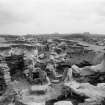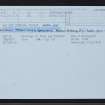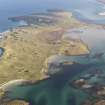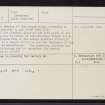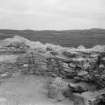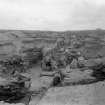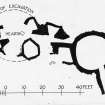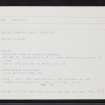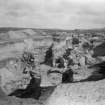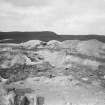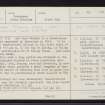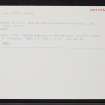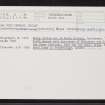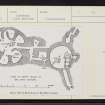Pricing Change
New pricing for orders of material from this site will come into place shortly. Charges for supply of digital images, digitisation on demand, prints and licensing will be altered.
Upcoming Maintenance
Please be advised that this website will undergo scheduled maintenance on the following dates:
Thursday, 9 January: 11:00 AM - 3:00 PM
Thursday, 23 January: 11:00 AM - 3:00 PM
Thursday, 30 January: 11:00 AM - 3:00 PM
During these times, some functionality such as image purchasing may be temporarily unavailable. We apologise for any inconvenience this may cause.
North Uist, Vallay, Bac Mic Connain
Souterrain(S) (Prehistoric), Wheelhouse (Iron Age)(Possible), Knife, Unidentified Pottery (Roman)
Site Name North Uist, Vallay, Bac Mic Connain
Classification Souterrain(S) (Prehistoric), Wheelhouse (Iron Age)(Possible), Knife, Unidentified Pottery (Roman)
Alternative Name(s) Bac Mhic Connain
Canmore ID 10054
Site Number NF77NE 5
NGR NF 7694 7619
Datum OSGB36 - NGR
Permalink http://canmore.org.uk/site/10054
- Council Western Isles
- Parish North Uist
- Former Region Western Isles Islands Area
- Former District Western Isles
- Former County Inverness-shire
NF77NE 5 7694 7619
(Area : NF 771 761) Bac Mhic Connain is a round-house discovered and excavated by Beveridge in 1919. It is situated on a sand-covered hillock on the tidal islet of Vallay, about 180 yards N of the bay at Saltam, in Vallay Sound, and a quarter-mile NW of vallay House.
Occupation over a long period was attested by the finds which included objects of stone (including some casting moulds), iron, bronze, bone and deerhorn, in addition to pottery which included a small fragment of Samian. A knife handle of cetacean bone bore an Ogham inscription which may be provisionally dated AD 6th to 8th century. The buildings had been extensively reconstructed during their use, and recently quarried: the plan should be regarded as tentative. (J G Callander 1932; L Scott 1948) Various finds are in the National Museum of Antiquities of Scotland (NMAS).
J G Callander 1932; L Scott 1948; Proc Soc Antiq Scot 1922; 1923; 1929.
The mutilated remains of this round-house, generally as planned by E Beveridge, are at NF 7694 7619.
Most of the internal diameter and five piers of the main building can be traced as wall-footings barely 0.3m high. The inside face of the second circular structure still stands to a height of 1.0 m. and the thickness of the walls cannot be ascertained. The adjoining passages and rectangular structure are too amorphous for survey.
Surveyed at 1/2500.
Visited by OS (J T T) 22 June 1965.
The Samian is possibly 2nd century AD.
A S Robertson 1970.
Bone dice found at unstated location; RMS GNB 65. Numbered 3, 6, 4, 5. Dots enclosed by circles. 33 x 9mm.
D L Clarke 1970; E W Mackie 1971.
Hanging-bowl escutcheon.
L Laing and J Laing 1986.
Field Visit (17 July 1924)
Earth-house, Bac Mhic Connain.
Rather more than ½ mile north-west of Vallay House a structure covered with sand was excavated in 1919 by Dr Erskine Beveridge. The walls stand for only a few courses, and the place has been silted up a good deal since the excavation was made. It was then found necessary also to fill in some of the compartments, as the stonework was caving in. In its present state the structure shows an unsymmetrical set of apartments, with one large circular room to the east, apparently at a higher level than the other apartments. In the western set was a hearth. For relics, including a bone with Oghams, see Proc. Soc. Ant. Scot., LVI., pp. 12-13.
RCAHMS 1928, visited 17 July 1924.
OS map: North Uist xxx.
Publication Account (2007)
NF77 1 BAC MHIC CONNAIN ('Vallay')
NF/7673 7537
This possible above ground wheel-house and associated round hut in North Uist were explored in 1919 (pron. 'Bahk Vick Connan'). In that summer Erskine Beveridge discovered the remains of buildings on one of the many sand-covered hillocks on the tidal island of Vallay and he spent five and a half weeks excavating it [2]. The usual practice of those times was followed; sand was cleared from the chambers which had been discovered by more or less random digging and there seems to have been no attempt to record stratigraphy, or to unravel a structural sequence. For these reasons no comprehensible overall plan of the site could be prepared and the outer wallface of the roundhouse, if it existed, was not located.
1. The structures
The main building seems to have been a circular house with seven bays formed by eight concave-side radial piers bonded to the wall. The entrance was evidently prolonged into the interior by the adjacent piers. The passage was also prolonged outwards and side chambers led off it; presumably there were some constructions outside the roundhouse. A hearth, a “furnace” (below), a stone box in the floor and various 'aumbries' or shelves in the wall were also found. There were traces of a kerb across the inner end of one bay.
Beveridge states that many sherds and bones were found on floor levels below the wall foundations so the finds may belong both to the roundhouse and to earlier occupations. However the roundhouse had evidently undergone considerable reconstruction but the details of all these aspects of the site are now irrecoverable without re-excavation. The second circular 'hut' seems to have been at a higher level and not to have been connected with the main roundhouse.
Tylecote [5] discusses the “furnace” found and offers a reconstruction based on Beveridge's verbal description; it may well be a rare example of a furnace for melting small quantities of bronze; slag and a fragment of a small triangular crucible were found inside it.
2. The finds
Details are given in the report of the objects found in the various bays but these are not linked to the finds catalogue. Recently Hallen (1994) has analysed some of the bone and antler finds from the site from the perspective of understanding the bone-working techno-logy employed.
Iron objects (not illus.) included the remains of a bone-handled knife (below); the missing pin with a ball-shaped bone head (below), slag and 5 rivets. A lump weighting 2.5 pounds is mentioned [3, 47].
Bronze: 1 pin with a flat, circular head (not illus.).
Bone: [3] among the more important artifacts are – 3 “spindle-like objects” one end of which has rotated in a socket (like a quern handle but appearing rather too small), 4 long-handled combs of whalebone, 1 decorated with an incised saltire (a St. Andrew's cross), (the complete one measuring 11.9cm in length), 2 bone borers and 2 whalebone awls, 1 socketed “harpoon” of a sheep's 'leg bone' 14.5cm (5.5 in) long (there is no hole for a line so the latter must have been tied on), 4 socketed “spearheads” (1 with 2 rivet holes in the socket), 1 fragment of a leg bone with an incised lattice design, 10 short, sawn segments of deer horn, 2 handles of iron knives (riveted to the stump of the blade and formed of two plates), 1 deer horn handle with a dot-and-two-circles motif incised on one side (most of the dot-and-circle motifs encountered in the Scottish Atlantic Iron Age were evidently drawn with a fine iron compass having a sharp central point and two slightly shorter ones which were rotated round this) and 2 heavy socketed handles made from the ends of cannon bones [fig. 10].
There were also 1 whalebone handle with an Ogham insciption which was read originally as MAQUNM?DENCOT (or DENCUT) ('Maq' is the equivalent of modern 'Mac' and could indicate an Irish name – but see 'Discussion'), 1 probable bridle cheek-piece of horn, 2 toggles made of perforated sheep's cannon bones, 1 two pronged flat implement of whalebone now 12.0cm (4.75 in) long (if the implement was originally the same at both ends it might have been used for winding thread or yarn on to), 2 whalebone punches or chisels, 1 deer horn 'bracer' 13.0cm (5 1/8 in) long with two holes, 1 possible deer horn whistle, 1 V-shaped horn object , 2 perforated sheep metatarsals, probably bobbins, 1 copy of an Iron Age 'La Tène' bronze mirror handle [7] (this is the only example of a link with the pre-Roman British decorative Celtic metalworking tradition known from Atlantic Scotland), 1 pear-shaped object with 2 perforations, 1 small conical pendant, 2 needles, 1 parallelopiped die with neatly inscribed dot-and-ring 'spots' arranged on the four long sides in the sequence 3-4-5-6, 1 notched whalebone mattock, 1 hollow ball-head for an iron pin, half of a whalebone mallet head 3.5cm (1/3/8 in) wide [3, fig. 4, 1], many antler tines and picks and many cut and worked fragments.
Stone objects included 2 moulds (1 for a bar), 2 certain and 10 probable quartzite pebble strike-a-lights, 1 quartzite pebble grooved on both faces (this sounds like another strike-alight), hammerstones, 1 pivot stone ('socket stone'), 11 pumice fragments, 1 fragment of a saddle quern, fragments of 3 rotary querns and 1 disc or pot lid.
Flint: 15 fragments.
Fired clay: 3 solid discs made from sherds, 1 broken perforated disc 19.0cm (7.75 in) in diameter, 4 complete (or nearly so) and 2 fragments of triangular crucibles (their bases partly vitrified by heat), 4 broken clay moulds (for casting the following items – a triangular ornament with a small ring at each angle [3, fig. 17, 6] and a flat ring about 5.7cm, or 2.25 in, in diameter), and 1 complete and 1 fragmentary mould for a small bar or ingot [3, fig. 17, 8 and 9].
Roman pottery: 1 small sherd of Samian ware [4].
Pottery: "the number of pieces of pottery received into the museum forms a very small proportion of those found ..." [4, 63]. Among these was a large plain pot without its rim found buried inverted under the raised hearth in Cell 1. The base lacks a foot and the pot looks like an Everted Rim jar [4, fig. 3].
3. Discussion
Beveridge's description seems to imply that there was more than one period of occupation at this site and the finds tend to confirm this. Although many of the finds and the pottery seem to form a fairly homogeneous middle Iron Age group there is some clear late Iron Age material. With the exception of the Ogam inscribed bone handle there is none of the standard late Iron Age material, such as composite bone combs and bone pins with decorative heads. Nevertheless the Ogam inscription is an important find and hints that a late Iron Age level may have been missed.
The 'La Tène' bone mirror handle is potentially an important piece, first because it is unique in Atlantic Scotland and second because it hints at some form of contact with the nearest zone of such metalwork – southern Scotland and northern England. Indeed the similarity with the bronze mirror handle from Lochlee crannog in Ayrshire is very striking [11, 225] (Munro 1882, 132, fig. 147).
The Ogam inscription on the whale-bone knife handle has been reinterpreted by Holder who suggests a reading of AQUL(N?)Q(C?)enuc?(T?) (Holder ms. 1990, 48-9). This is "unintelligible Pictish" which, if correct, would not support the idea of someone with an Irish 'Mac' name on the site (f.n. 264).
Sources: 1. NMRS site no. NF 77 NE 5: 2. RCAHMS 1928, 89, no. 271 and fig. 151: 3. Beveridge and Callendar 1932, 42-66: 4. Scott 1948, 75-76: 5. Tylecote 1962, 36-37, 194 and 199: 6. MacGregor 1976, 9, 141, 143 and 163, no. 271: 7. Armit 1992, 54-5: 8. Crawford 2002, 118: 9. Armit 1996, 139, 145, 152, 162, 180: 10. Clarke 1970, 229, no. 4: 11. Hallen 1994: 12. Laing and Laing 1987, 215: 13. Lane 1988, 55-6: 14. Robertson 1970, Table 4: 15. Proc Soc Antiq Scot 57 (1922-23), 110 (donations): 16. Proc Soc Antiq Scot 63 (1928-29), 363 (donations): 17. Proc Soc Antiq Scot 56 (1921-22), 12-13 (donations).
E W MacKie 2007




















